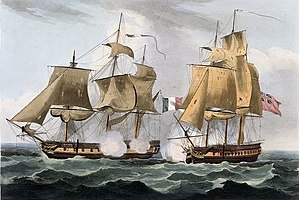 Print by Thomas Whitcombe depicting HMS Carysfort retaking Castor from the French on 29 May 1794
| |
| History | |
|---|---|
| Name | HMS Carysfort |
| Namesake | John Proby, 1st Baron Carysfort, former Lord of the Admiralty |
| Ordered | 4 & 20 February 1764 |
| Builder | Sheerness Dockyard |
| Laid down | June 1764 |
| Launched | 23 August 1766 |
| Completed | 11 August 1767 |
| Commissioned | June 1767 |
| Honours and awards | Naval General Service Medal with clasp "Carysfort 29 May 1794" |
| Fate | Sold on 28 April 1813 |
| General characteristics | |
| Class and type | 28-gun Coventry-class sixth-rate frigate |
| Tons burthen | 58630⁄94 (bm) |
| Length |
|
| Beam | 33 ft 8 in (10.3 m) |
| Depth of hold | 10 ft 6 in (3.20 m) |
| Sail plan | Full-rigged ship |
| Complement | 200 |
| Armament |
|
HMS Carysfort was a 28-gun Coventry-class sixth-rate frigate of the Royal Navy. She served during the American War of Independence, the French Revolutionary and the Napoleonic Wars in a career that spanned over forty years.
She had a number of notable commanders during this period, and saw action in several single-ship actions against French and American opponents. She took several privateers during the American War of Independence, though one of her most notable actions was the recapture of Castor, a Royal Navy frigate that a French squadron had captured nearly three weeks earlier and a French prize crew was sailing to France. Carysfort engaged and forced the surrender of her larger opponent, restoring Castor to the British, though not without a controversy over the issue of prize money. Carysfort spent the later French Revolutionary and early Napoleonic Wars on stations in the East and later the West Indies. Carysfort returned to Britain in 1806 where she was laid up in ordinary. The Admiralty finally sold her in 1813.